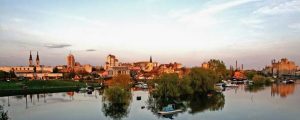Pancevo is a town in Banat, on Tamiš. Territorially, Pancevo is the seat of the municipality of the same name as the South Banat District (Vojvodina, Serbia). There are 76,654 people living in the city, 130,280 in the municipality. Together with the suburban settlement Starčevo grad Pančevo according to the last 2002 census, there are 84,702 inhabitants.
Pancevo is located at 77 meters above sea level, at coordinates 44 ° 54 ‘north and 20 ° 40’ east. It is located 18 km northeast of Belgrade, the capital of the Republic of Serbia, at the delta of the Tamiš in the Danube. The territory of Pančevo is considered one of the hottest areas of Vojvodina, with an average annual temperature of 11.3 ° C and more than 100 sunny days during the year. The average annual value for relative humidity is 77%. Precipitation is greatest at the end of the spring, early summer, late autumn and early winter. The average amount of precipitation during the year is about 643mm.

Pancevo belongs to the area of moderate continental climate, with four seasons, characterized by long and warm summer and autumn, mild winters and short spring. A particular specificity of the climate is a basket, a strong and dry wind that lasts up to three weeks. In addition to the basket, there are also a lot of Southwest, West and North winds. The number of windy days during the year is 45, and the highest humidity is during the months with the lowest temperature (November, December, January and February).
The oldest name of the settlement that was located on the site of today’s Pančevo, at the delta of the Tamiš in the Danube, is Panuka. Due to frequent changes of the masters (Romans, Celts, Huns, Avars, Slavs, Hungarians, Tatars, Turks, Germans), the name of this strategically important place is often changed. From Panuka became Panucea or Panuča in the 10th century, Bansif in the 12th century, in the 15th century Pančal and Pensej, in the 17th century Pajčova or Panziova and Bančova even in the early 18th century as Čomva. For the first time in history it is mentioned as a city, a commercial venue, in 1153, which, among others, is settled by the Greeks, of course, due to trade. In the 15th century it was occupied by the Turks and held under its authority until 1716. Under the Austro-Hungarian name it is called Comova and then Pančova, and since 1918 Pančevo.
In the Middle Ages, Pančevo belonged to the metropolitan area. After the Peace of Požarevac and the liberation from the Turks (1716), the entire Banat is part of the Austro-Hungarian monarchy as an autonomous region called the Tamiški Banat. Then begins the rapid settlement of these regions. A large number of Serbian families move to Pančevo from Timisoara and the surrounding area, and the Germans from France are also immigrating. From 1716. to 1764., Pančevo was maritime, and from 1764. to 1794., the military-border trade market.
After the First World War, the Pančevo industry experienced its second youth and became one of the industrial giants of the former Yugoslavia. Many factories are opening that employ tens of thousands of workers from Pancevo, Belgrade and the surrounding towns from almost the entire Banat.
